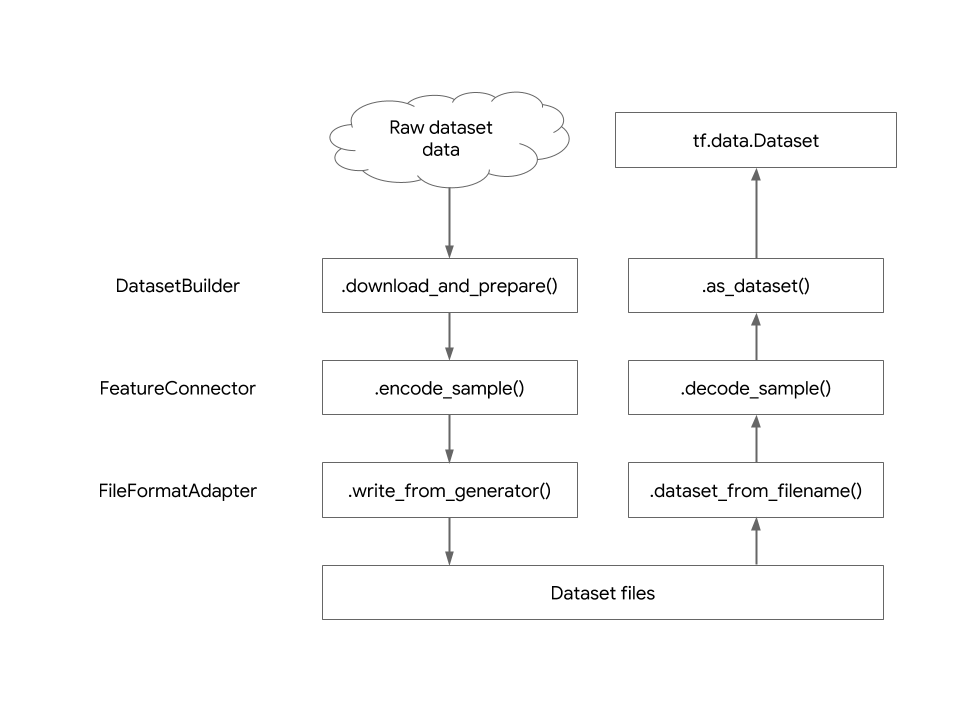tfds.features.FeatureConnector API
- 定义最终
tf.data.Dataset的结构、形状、数据类型 - 抽象化到/从磁盘的序列化。
- 公开其他元数据(例如标签名称、音频采样率,...)
概览
tfds.features.FeatureConnector 定义数据集功能结构(在 tfds.core.DatasetInfo 中)
tfds.core.DatasetInfo(
features=tfds.features.FeaturesDict({
'image': tfds.features.Image(shape=(28, 28, 1), doc='Grayscale image'),
'label': tfds.features.ClassLabel(
names=['no', 'yes'],
doc=tfds.features.Documentation(
desc='Whether this is a picture of a cat',
value_range='yes or no'
),
),
'metadata': {
'id': tf.int64,
'timestamp': tfds.features.Scalar(
tf.int64,
doc='Timestamp when this picture was taken as seconds since epoch'),
'language': tf.string,
},
}),
)
可以通过仅使用文本描述(doc='description')或直接使用 tfds.features.Documentation 来记录功能,以提供更详细的功能描述。
功能可以是
- 标量值:
tf.bool、tf.string、tf.float32,... 当您想记录特征时,还可以使用tfds.features.Scalar(tf.int64, doc='description')。 tfds.features.Audio、tfds.features.Video,...(请参阅可用特征的列表)- 嵌套特征
dict:{'metadata': {'image': Image(), 'description': tf.string} },... - 嵌套
tfds.features.Sequence:Sequence({'image': ..., 'id': ...})、Sequence(Sequence(tf.int64)),...
在生成期间,示例将由 FeatureConnector.encode_example 自动序列化为适合磁盘的格式(当前为 tf.train.Example 协议缓冲区)
yield {
'image': '/path/to/img0.png', # `np.array`, file bytes,... also accepted
'label': 'yes', # int (0-num_classes) also accepted
'metadata': {
'id': 43,
'language': 'en',
},
}
在读取数据集时(例如使用 tfds.load),数据将使用 FeatureConnector.decode_example 自动解码。返回的 tf.data.Dataset 将与 tfds.core.DatasetInfo 中定义的 dict 结构匹配
ds = tfds.load(...)
ds.element_spec == {
'image': tf.TensorSpec(shape=(28, 28, 1), tf.uint8),
'label': tf.TensorSpec(shape=(), tf.int64),
'metadata': {
'id': tf.TensorSpec(shape=(), tf.int64),
'language': tf.TensorSpec(shape=(), tf.string),
},
}
序列化/反序列化为 proto
TFDS 公开了一个低级 API,用于将示例序列化/反序列化为 tf.train.Example proto。
要将 dict[np.ndarray | Path | str | ...] 序列化为 proto bytes,请使用 features.serialize_example
with tf.io.TFRecordWriter('path/to/file.tfrecord') as writer:
for ex in all_exs:
ex_bytes = features.serialize_example(data)
f.write(ex_bytes)
要将 proto bytes 反序列化为 tf.Tensor,请使用 features.deserialize_example
ds = tf.data.TFRecordDataset('path/to/file.tfrecord')
ds = ds.map(features.deserialize_example)
访问元数据
参阅简介文档以访问特征元数据(标签名称、形状、数据类型等)。示例
ds, info = tfds.load(..., with_info=True)
info.features['label'].names # ['cat', 'dog', ...]
info.features['label'].str2int('cat') # 0
创建自己的tfds.features.FeatureConnector
要创建自己的特征连接器,您需要从tfds.features.FeatureConnector继承并实现抽象方法。
- 如果您的特征是单个张量值,最好从
tfds.features.Tensor继承并在需要时使用super()。请参阅tfds.features.BBoxFeature源代码以获取示例。 - 如果您的特征是多个张量的容器,最好从
tfds.features.FeaturesDict继承并使用super()自动编码子连接器。
tfds.features.FeatureConnector对象抽象了特征在磁盘上的编码方式与向用户呈现的方式。以下是显示数据集抽象层以及从原始数据集文件到tf.data.Dataset对象的转换的图表。

要创建自己的特征连接器,请对tfds.features.FeatureConnector进行子类化并实现抽象方法
encode_example(data):定义如何将生成器_generate_examples()中给出的数据编码到与tf.train.Example兼容的数据中。可以返回单个值或值的dict。decode_example(data):定义如何将从tf.train.Example中读取的张量中的数据解码为tf.data.Dataset返回的用户张量。get_tensor_info():指示tf.data.Dataset返回的张量形状/数据类型。如果从另一个tfds.features继承,则可以是可选的。- (可选)
get_serialized_info():如果get_tensor_info()返回的信息与数据实际写入磁盘的方式不同,则需要覆盖get_serialized_info()以匹配tf.train.Example的规格 to_json_content/from_json_content:需要此项才能在没有原始源代码的情况下加载数据集。请参阅 音频功能 以获取示例。
有关更多信息,请查看 tfds.features.FeatureConnector 文档。最好还查看 实际示例。
